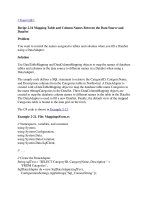FinTech, open source, and emerging markets
Bạn đang xem bản rút gọn của tài liệu. Xem và tải ngay bản đầy đủ của tài liệu tại đây (790.63 KB, 36 trang )
Fintech, Open Source, and
Emerging Markets
Digital Banking for Everyone
Cornelia Lévy-Bencheton
Fintech, Open Source, and Emerging Markets
by Cornelia Lévy-Bencheton
Copyright © 2016 O’Reilly Media Inc. All rights reserved.
Printed in the United States of America.
Published by O’Reilly Media, Inc., 1005 Gravenstein Highway North,
Sebastopol, CA 95472.
O’Reilly books may be purchased for educational, business, or sales
promotional use. Online editions are also available for most titles
(). For more information, contact our
corporate/institutional sales department: 800-998-9938 or
Editors: Nan Barber and Brian Foster
Production Editor: Shiny Kalapurakkel
Copyeditor: Octal Publishing, Inc.
Proofreader: Charles Roumeliotis
Interior Designer: David Futato
Cover Designer: Karen Montgomery
Illustrator: Rebecca Demarest
September 2016: First Edition
Revision History for the First Edition
2016-09-14: First Release
The O’Reilly logo is a registered trademark of O’Reilly Media, Inc. Fintech,
Open Source, and Emerging Markets, the cover image, and related trade
dress are trademarks of O’Reilly Media, Inc.
While the publisher and the author have used good faith efforts to ensure that
the information and instructions contained in this work are accurate, the
publisher and the author disclaim all responsibility for errors or omissions,
including without limitation responsibility for damages resulting from the use
of or reliance on this work. Use of the information and instructions contained
in this work is at your own risk. If any code samples or other technology this
work contains or describes is subject to open source licenses or the
intellectual property rights of others, it is your responsibility to ensure that
your use thereof complies with such licenses and/or rights.
978-1-491-96779-9
[LSI]
Preface
Banking. That old, established, venerated industry is under siege. Digital
technologies, changing demographics, and demanding consumers are all
colliding. Financial technology, or fintech, startups are coming on stream and
no one is able to predict how the competition will reshape legacy bank
infrastructure and customary thinking. There is an atmosphere of instability
combined with excitement.
“Data, Money, and Regulation: The Innovation Dilemma,” our first O’Reilly
financial report, discusses how heavily regulated, technologically challenged
financial services and banking are at odds with innovation. The need to adapt
and become agile could not be more apparent.
“Data Science, Banking, and Fintech: Fitting It All Together,” our second
report, examines the disruptive impact of fintech and reviews key
participants, products, and technologies. With their massive infrastructure
investments and decades-old client relationships, banks have a distinct
advantage. How might they fight back against the new crop of fintech
companies chipping away at their dominant market position? A strategy and
survival plan for continuing relevance are in order.
This report, “Fintech, Open Source, and Emerging Economies: Digital
Banking for Everyone,” is the third in this series. Here, we examine how
fintech is connecting previously isolated financial systems and populations,
allowing them to share in transformative economic benefits. In the
developing world, fintech and mobile technologies enable needed financial
inclusion. The new, digitally connected world is one in which everyone
should have (and can have) access to data and to the financial marketplace.
The entire economic pyramid can benefit, not just those at the top. Other
market forces are working together, zeroing in on the unbanked to
demonstrate how philanthropy and profitability do not have irreconcilable
differences.
Buckle your seatbelts: banks are evolving into tech companies with options.
A digitally enabled customer experience is front and center.
Chapter 1. It’s the End of
Banking (as We Know It)
The year is 1995. Terminator 2: Judgment Day, the box office smash hit
directed by James Cameron, explores the battle for survival between the
human race and Skynet, a highly advanced artificial intelligence construct
that threatens our civilization with extinction. Working through servers,
mobile devices, drones, military satellites, robots, sentient computers,
androids, and cyborgs, the film leads us to picture a radically different
futurescape, one not unlike our technically sophisticated landscape of today.
With advents in fields like robotics and artificial intelligence, the tension,
uncertainty, and chaos of this entertaining cinema classic accurately mirror
the current state of the financial world, disrupted as it is by the shadow of
impending change cast by financial technology (fintech) and now Brexit.
It’s the end of banking as we know it.
Things have never been more unsettled since the anxious period after the
2008 financial crisis. Currently, the problem is not the misbehavior of big
banking institutions but rather the limits of those institutions and the threat of
disintermediation coming from startups that are faster, simpler, and cheaper,
and also offer vastly improved customer experiences. In today’s financial
ecosystem, there is much ado about experimentation through myriad new
formats, including accelerators, labs, incubators, acquisitions, and
partnerships involving stakeholders throughout the value chain, all diligently
working on a response.
Banks are scrambling to find their way. And the frenzy often seems driven by
fear, desperation, hope, and copycatting success from other fields like Uber
or AirBnB. The incumbents are seeking out adaptive strategies in their rush
to grow market share and to stay competitive and relevant...much like the
humans trying to escape extinction in Terminator 2.
We covered key aspects of fintech, the disruptive megatrend taking hold of
the financial world, in another O’Reilly Report, “Data Science, Banking, and
Fintech: Fitting It All Together,” in which we reviewed key participants,
products, and technologies.
In this report, we focus on several unexpected and extraordinary
consequences of the fintech evolution enabled by digital and mobile
technologies and the ubiquitous smartphone:
Big new commercial opportunities in global emerging markets making
the efforts of investors, startup founders, and tech visionaries
worthwhile
The socially transformative impact of fintech on financial inclusion for
the previously unbanked
A trickle-back effect from emerging market activity reshaping and
affecting the future of fintech and financial services in the developed
world
The Fintech State of Mind
Fintech is not a phenomenon located in the isolation of banking centers in
New York, London, and Singapore. It is closely associated with the financial
services industry, which plays a key part in almost every major life decision
we make, from buying a home to opening a bank account, setting up a credit
card, starting a business, paying for a college education, or retiring, no matter
where we are located. Fintech is about making the role banks and financial
services play easier and more efficient. It is the oil, the fuel, the platform, the
electric current through which money is moved, spent, saved, and loaned. It
is not the preserve of old, white men in pinstriped suits meeting in stuffy
conference rooms. It is the agora, the gathering place, the bazaar or
marketplace for a wide variety of consumers at all levels and backgrounds of
the economic pyramid to come together to transact. It is global and it is local.
In part, what has accounted for the excitement, interest, and investment
capital in fintech are big, new disruptive ideas, particularly in the payments
area: there are emerging technologies and platforms such as the Internet of
Things (IoT), robotics, and AI, as well as fascination with distributed ledgers
and blockchains (and the new technology layers added via the blockchain).
Fintech overall, however, is much broader than that. Fintech is a movement
and a concept in addition to being a technology. Elizabeth Lumley, director
of global ecosystem development at Startupbootcamp FinTech and
Startupbootcamp InsurTech — as well as a prominent fintech luminary —
defines fintech as follows, adding a potent redirect to understanding what
fintech really represents:
Don’t pigeonhole the benefits of fintech. ... Fintech is a mindset, not a
sector. It’s the way you develop products around a consumer or business
problem and that’s the real benefit fintech will have on this industry.
Consider this: digital and mobile technologies with fintech applications bring
efficiency, effectiveness, and more comfortable living to Western
populations. We all have smartphones. And we don’t think twice about
consulting our handheld devices numerous times a day. We use them for
everything from texting to email to Internet access and calendar
appointments. A wide variety of app choices allows us to download, upload,
or go shopping all day long. Point, swipe, click, and we’re done.
But to the less fortunate, these platforms provide access to far more basic
needs. They are connecting previously isolated systems and populations,
allowing them to share in economic and financial benefits that completely
transform their lives. Fintech in emerging societies ushers in a dramatic leap
forward in economic progress for the underserved, unbanked, and
underbanked. Thanks in large part to the ubiquitous mobile phone and now
the smartphone, poorer countries have become hot spots and big business,
revenue, and market opportunities.
Chapter 2. Mobile Enabling
Broad Change
Wallets stuffed with credit cards, ATMs on every corner, meals ordered up
through Seamless, vacations via Airbnb, the Uber app ready to get us where
we want to go. Why carry cash? It’s no longer necessary. Swipe, point, and
click. Need to see your balance? How about a loan? No problem. This is what
normal looks like for most of us today. This is inclusion. It is hard for those
of us living in first-world, industrialized nations to picture anything other
than the digitized convenience to which we have become accustomed and the
privileges afforded by access to financial services.
For Others, a Very Different Story
But, here’s what exclusion looks like. In third-world or developing countries,
for those living at the base of the economic pyramid, cash still reigns
supreme. Buying something requires carrying cash around or hiding it
somewhere around the house at the risk of being robbed. Sending money to a
friend or relative in need can mean taking a day off from work without pay,
or, perhaps, taking a child out of school or not bringing the child to school at
all if that can’t be arranged. Delivering the cash in person is dangerous
because a robbery could happen along the way. Trusting someone with
delivery carries the risk that it might never reach its destination. In an
emergency, borrowing money incurs extortionate usury rates from
moneylenders. Investment means buying another chicken or goat which will
lose value over time. If your money is tied up in investment property like
animals or jewelry, how do you make a payment?
Africa Heating Up as a Mobile Money Market
For purposes of this report, we spotlight Africa as an example. Of course,
fintech comes into play in other emerging markets as well. However,
although those populations and opportunities are sizeable, including them
here skews our discussion with dissimilar variables.
Why is Africa a good example? With its young demographic, it has
successfully integrated mobile financial technology into daily living. Africa
has a very young population. They are digital natives whose average age is
18 (by comparison, in the United States, the average age is 37) and we know
that population age is highly correlated to speed of technology adoption.
Another factor is infrastructure or lack thereof. African precincts are not
dotted with brick and mortar bank branches and so legacy banks, regulations,
and habits have not gotten in the way of penetrating this market. African
populations are extremely receptive to mobile tech development. Even in
sub-Saharan Africa, about 12 percent of adults already have mobile bank
accounts, compared to about 2 percent globally. Lastly, a large percentage
(about 80 percent) of Africa’s adult population does not use formal financial
services. The upside potential is enormous.
In a recent report, the Consultative Group to Assist the Poor (CGAP)
recognizes stand-out opportunities for fintech companies in four African
countries (see Figure 2-1): Kenya, Tanzania, Ghana, and Rwanda. Kenya and
Tanzania had previously been identified as mobile money success stories
because more adults there had mobile money accounts than had bank
accounts. According to new information, technology can also be effective in
other African markets like Rwanda and Ghana. Key factors in Ghana include:
1) 92 percent of adults in Ghana have the required ID necessary to open an
account, 2) a 95 percent rate of numeracy, and 3) 91 percent of Ghanaians
already own a mobile phone. Poorer populations in the developing world
often do not have a formal financial history or identity records. Some don’t
have identity documents (like birth, graduation, or marriage certificates). As
mobile subscriptions have risen dramatically across Africa, the cost per
device has dropped, making phones very affordable and allowing widespread
use of smartphones to bring more people online across the continent. Along
with declining price, improved infrastructure, faster transmission speeds, and
better connectivity for popular social products like Facebook and Twitter,
financial services too, can now reach a growing middle class as well as
Africa’s remote rural areas.
Figure 2-1. Fintech mobile money opportunities in four African countries. (rendered by Cornelia LévyBencheton; source: page 4)
Mobilizing with Financial Data
It’s all about the data. And mobile data is the silent engine driving financial
inclusion and the new products that will certainly emerge in the future. Even
at a very early stage, there is much promise and potential in the data being
gathered, mined, and analyzed. Analyzing data from mobile wallets and cell
phone usage is the gateway to product innovation. In developed countries,
people are already storing money digitally on their phones and using them to
make purchases, as if they were debit cards. By 2020, 2 billion people who
don’t have a bank account today will be doing the same thing. And after that,
mobile money providers will be offering the full range of financial services,
from interest-bearing savings accounts to credit, insurance, and other
facilities that we can only imagine.
It seems unlikely that the lack of traditional financial infrastructure will
change anytime soon because the cost of creating it would be prohibitive and
unnecessary — millions of people don’t even have access to cash machines
or bank branches. It also seems unlikely that this will stop the pace of
progress. What is more likely is that mobile money transfer transaction
volumes and revenues will rise, purchasing power for consumers will
increase through online access, the standard of living will continue to
improve, tax revenues for governments will grow, and banking and telecom
companies will have increasing opportunities to grow their businesses.
For providers, mobile is the gateway to innumerable financial services
delivery such as money transfer, cash deposits and withdrawals, third-party
deposits into a user account, retail purchases, prepaid cards fueled by cash,
and other services, all of which have a much higher adoption potential with
and on mobile. Mobile applications provide a common development and
ready-made distribution platform.
Just M-Pesa Me the Money
Professional photographer and photojournalist Wendy Stone, who lived in
Kenya for 24 years starting in 1988, witnessed the breathtaking life style and
cultural changes brought about by M-Pesa as she traveled throughout Africa
working on projects for numerous NGOs, international organizations, and
creative and media outlets. Initially launched in 2007 in Kenya by Safaricom
(a subsidiary of Vodafone) as a means of facilitating microfinance to avoid
some of the inefficiencies of the country’s cash economy, M-Pesa took off. It
was an immediate hit. During our interview, Stone recalls:
It changed our lives in a very dramatic way. The average Kenyan does not
have bank accounts. But they do have mobile phones. It’s a rural society,
they’re agriculturalists [see Figure 2-2 and Figure 2-3]. The majority of the
people still live on tiny homesteads called in Kiswahili “shambas.” M-Pesa
works on a very basic level. If they want someone to send money, they’ll
say, “M-Pesa that, please.” Nobody uses a bank check. Credit cards are
extremely rare. People want to be M-Pesa’d because it’s an easy and safe
way to move cash. And it’s instantaneous. Instantaneous! That’s the thing.
It doesn’t have to go through the banking system.
Figure 2-2. An entrepreneurial woman farmer engaged in a thriving microbusiness in Kisumu, the
largest marketplace in Western Kenya (photo courtesy of Wendy Stone/Getty Images; used with
permission)
Figure 2-3. M-Pesa facilitates transportation and sale of vegetables and produce from remote villages
to thriving commercial markets like the one above in Kenya (photo courtesy of Wendy Stone/Getty
Images; used with permission)
With M-Pesa, a few taps on a cellphone enables people in Kenya to send and
store money, pay bills, or even run a business from the palm of their hand.
With more than 20 million users currently, M-Pesa enjoys the distinction of
being the world’s most widely used mobile money transfer and financial
network, and Kenya leads the way in mobile money. A variety of
circumstances contributed to Kenya’s success, not the least of which is access
to fiber-optic cables running under the sea from the Arabian Peninsula.
Safaricom’s far-reaching M-Pesa network strategy laid the foundation to
broadly expand the market, allowing connecting partnerships with more than
140 financial institutions and revolutionizing the ability of banks to scale up
fast. M-Shwari, an account combining savings and loans, and M-Changa, an
app for lending and crowdfunding, are examples of highly networked
products that reach millions of people quickly. Previously, money exchanged
hands (largely via cash — in person or remotely) in a centuries-old practice
known as harambee (Kiswahili for fundraising) without transparency. All
that is changing.
Many m-payment services have sprung up with collaboration between banks,
mobile network services, and payment providers. As of this writing, it is not
known whether there is one network that can connect the entire African
continent and all its countries with network interoperability. However, the
activity and product potential make Africa a giant experimental laboratory in
defining the future of money, banking, and mobile technology. It is
remarkable that Africa has so quickly caught up to the developed world,
skipping over the stages of brick and mortar infrastructure and accompanying
red tape, and going straight to mobile tech.
The Gender Differential
An unexpected consequence of the success of mobile technology in countries
such as Kenya is the spectacular improvement of individual and household
welfare and the spike of activity in micro-, small-, and medium-sized
enterprises and in cottage industries, many of which — surprisingly — are
run by women (Figure 2-4 and Figure 2-5). Stereotypical casualties of the
gender gap and certainly cast as underrepresented minorities in tech, women
are now taking the lead as both beneficiaries and drivers of economic
development in this new business model. Women have become emboldened
as entrepreneurs by the handheld mobile phone. In our interview, Wendy
Stone explains how the dynamism of women is very much a cultural and
historical artifact:
Women have always been the workers in developing countries, not the
men. It’s a cultural difference. Traditionally, a man’s job was to take care
of the livestock and settle any clan or tribal disputes. That was the role of
men. The women are the real workers. They take care of everything else.
Figure 2-4. Ēmilienne, a successful peanut cookie trader and entrepreneur in Benin, West Africa
(photo by Kakpota, Benin, courtesy of The Hunger Project; used with permission)
Figure 2-5. Microfinance at the Ndereppe Epicenter in Senegal (photo by Johannes Odé, courtesy of
The Hunger Project; used with permission)
Megan Colnar, director of monitoring, evaluation, and learning at The
Hunger Project1 ( who has lived in Kenya and is now
working in the eight African countries where her organization has a presence,
confirms, during our interview, the strategic importance of targeting and
including women as a make it or break it success factor:
Women are less likely to own phones. But, even with mobile banking, if
you’re not targeting women specifically and if you’re not really looking
and caring for their needs, understanding why women don’t have phones
as often as men and looking into some of those social factors as well as the
physical and geographical factors, you might miss the mark in delivering
the kind of services with the success you hope to achieve.
Because women are also 28 percent less likely than men to own an account at
a financial institution according to a recent report by the Consultative Group
to Assist the Poor (CGAP; on adults in
developing countries living below the $2/day poverty line, it would be easy to
overlook how critical their involvement is.
The Hunger Project deploys mobile phones as though they were Internet of
Things (IoT) connectivity devices to collect, manage, share, and document
program inputs, outputs, outcomes, and especially impacts on its network. It
uses sophisticated data-driven and digitized research techniques to measure
progress on its many initiatives in eight African countries including Benin,
Burkina Faso, Ethiopia, Ghana, Malawi, Mozambique, Senegal, and Uganda.
Through iFormBuilder, a mobile data collection platform for iOS and
Android, it has established that projects in rural, emerging, and sub-Saharan
territories can be measured and monitored.
Through financial services provided as part of The Hunger Project’s
Epicenter Strategy, rural women are better equipped to launch their own
income-generation projects and invest the profits toward the financial
independence needed to improve the lives of their families. Because mobile
phone reception and computer literacy is expanding, the rural banks, set up in
partnership with The Hunger Project, are increasingly able to digitally track
loan and savings accounts.
Those living in poverty are even more so required to make strategic choices
about the products they need. Megan Colnar shared additional insights from
her work in Africa: “Poor people are just as savvy about buying things and
knowing what they need. Conscious of value, they are interested in end
products that meet those needs.” She cited a market research study in Kenya
by Gamos: “The Next Generation of Low-Cost Energy-Efficient Appliances
and Devices to Benefit the Bottom of the Pyramid” (known as the LCT
[Low-Cost Technologies] project). The report uses discrete choice modeling
with logistic regression to fit predictive models for the technology options
proposed. Although not specifically about financial services, it clearly shows
how poor people know exactly what they need and what they are willing to
pay for products and services that meet those needs, even products that cost a
bit more. Countries such as Kenya have created products ahead of many
developed countries. Africans, for example, were texting money with M-Pesa
years before Venmo arrived on the scene in the developed world.
Another organization that works in this space, Women’s World Banking,
identifies the same trend of rural women transformed into microentrepreneurs, emboldened through computer literacy and advancing down
the highway to financial inclusion. Its website is replete with stories, blogs,
anecdotes, and research detailing how women — inherent savers and quite
thrifty — when they are empowered, do the heavy lifting to create small
enterprises, taking responsibility for the education, health, and welfare of
their families.
Smartphone screens that replace bank tellers in our culture are replacing
banks altogether in the developing world. With their built-in database and
memory capability for audit and tracking, these also serve as IoT devices that
capture data, record transactions, and serve as sensing dashboards to monitor
activity. The rate of adoption is phenomenal as is the data-mining potential. It
is the smartphone that has leapt over habitual structure and process to
transform culture. And now the developing countries are leading us onward.
1
The Hunger Project is a global nonprofit organization whose mission is to end hunger and poverty
by pioneering sustainable, grassroots, women-centered strategies and advocating for their
widespread adoption in countries throughout the world. The Hunger Project works in 12 countries
across Africa (Benin, Burkina Faso, Ethiopia, Ghana, Malawi, Mozambique, Senegal, and Uganda),
South Asia, and Latin America.
Chapter 3. An Expanding
Universe of Stakeholders and
Players
New, unexplored markets beckon and the profit motive is not dormant. A
business opportunity is a business opportunity. Many factors offer attractive
returns to established players looking for growth, market testing of use cases,
and compensatory strategies for offsetting downside risks back at
headquarters. Meanwhile, philanthropic organizations see light at the end of
the tunnel.
Fintech: Unstoppable Growth
The explosive growth in fintech is undeniable. And it does not look to be
slowing down anytime soon. Venture capitalists, private equity firms,
corporations, and others have poured an unprecedented amount of money into
global financial technology startups. The fintech industry and its everexpanding ecosystem promise to be gigantic in years to come. The number of
investments and acquisitions is increasing year-over-year at an incredible
rate. The spectacular growth seen in 2014 of $12.7 billion USD (quadrupling
the $3 billion USD level of the year before) was overshadowed in 2015 by
the stunning figure of $22.3 billion USD, an increase of 75 percent, including
startups and investments. And this breathtaking expansion continues. Already
in Q1 2016 fintech investments have surpassed the same period for last year,
challenging our expectations of growth of any kind associated with financial
services.
According to an Accenture report, collaborative fintech ventures — those
primarily targeting financial institutions as customers — are gaining ground
over so-called “disruptive” players that enter the market to compete against
those institutions. Funding for collaborative fintech ventures, which
accounted for 38 percent of all fintech investment in 2010, grew to 44 percent
of funding in 2015, with the remaining investments made in ventures that
compete with financial institutions.
Mobile Heating Up, in Step
Mobile and fintech are in lockstep. According to the Mobile Ecosystem
Forum, all areas of mobile money are showing growth including carrier
billing, proximity payments, person-to-person (P2P) transfers and services
for the unbanked, and contactless payments — all pointing the way to the
future. IDC forecasts of worldwide mobile payments, made using mobile
devices, are reflected in Figures 3-1 and 3-2. Does this dramatic growth mean
the end of physical cash?
Figure 3-1. Growth of worldwide mobile payments volume (rendered by Cornelia Lévy-Bencheton;
source: />
Figure 3-2. Growth of worldwide mobile subscribers (rendered by Cornelia Lévy-Bencheton; source:
/>
Such spectacular growth will clear the way for development and adoption of
numerous new device and product innovations in funds transfer, account
types, retail purchases, and prepaid services.
Ready for Another 2.5 Billion Customers?
That’s what’s available. World Bank research tells us that there are more than
2 billion people — or 38 percent of all adults on the planet — who don’t have
access to the most basic financial services. And 2.5 billion have no banking
account. This includes more than half of adults in the poorest 40 percent of
households in developing countries. Essentially, we should consider that
about 73 percent of the world’s population is unbanked, that is, financially
excluded. And that is an extraordinary opportunity. A huge number of
companies including micro, small, medium, and large enterprises are
commercially in need. The developing world has huge masses of new
prospects and customers and needs the resources to satisfy and manage these.
The International Finance Corporation (IFC) estimates at more than 200
million the number of these enterprises in developing economies that are
unserved or underserved in their financing needs.
The explosive growth of fintech and mobile platforms makes emerging
markets a hotspot, hot market, and pivotal hub for digital technology and
mobile commerce development. This creates a digital marketplace where
consumers and businesses alike can participate for market share, revenue, and
new products. Some of the common factors that are going to propel this
growth are P2P payments, cross-border and intercontinental money transfers,
mobile commerce, proximity payments, wallets, and government services
that are going mobile.
Fast Tracking on the Inclusion Bandwagon
The time has never been better to take advantage of new consumer and
business opportunities in emerging markets. The Universal Financial Access
initiative (UFA2020: was launched in 2015 by the
World Bank, the International Monetary Fund (IMF), and the International
Finance Corporation (IFC). Teaming up with a broad global coalition of 14
partners, it has pledged commitments for 1 billion financially excluded adults
to gain access to formal financial services by 2020. The project details
strategies, diagnostic measurements, and tracking across the 25 targeted
countries where 73 percent of the world’s financially excluded are located.
Included are 12 of Africa’s 56 countries.
Players abound. The World Bank, the Gates Foundation, IMF, IFC, M-Pesa,
M-Kopa, Cellulant, MFS Africa, Tigo, Airtel, MTHN, Vodaphone, The
Hunger Project, Women’s World Banking (some of which you’ve seen in this
report), along with other multinational agencies, foundations, banks, credit
unions, card companies, microfinance institutions, networks,
telecommunications companies and carriers, and device manufacturers are
some of the broad-ranging organizational forces to converge on the financial
inclusion bandwagon, a meeting of both financial and social value incentives.
In June of this year, MasterCard increased its UFA2020 commitment, setting
an additional goal to connect 40 million micro and small merchants to its
electronic payments network within five years. Under the leadership of Ajay
Banga, president and CEO of MasterCard, the firm has redefined itself as a
“technology” company, not just a card company, and strengthened its
intention to use technology in the global digital payments ecosystem to bring
consumers, financial institutions, and merchants into the financial
mainstream.
Although a clear philanthropic movement is underway — affecting social
good and inclusion for the underserved, unbanked, and underbanked —
mobile money and fintech agility are adding to shareholder financial value.
Philanthropy and the profit motive are not at odds.









